Sales of organic pulse isolates for clean-protein claims in Latin America are estimated at USD 0.52 billion in 2025, with projections indicating a rise to USD 1.05 billion by 2035, reflecting a CAGR of approximately 7.3% over the forecast period. This growth reflects both expanding middle-class wellness awareness and increased adoption across functional nutrition categories.
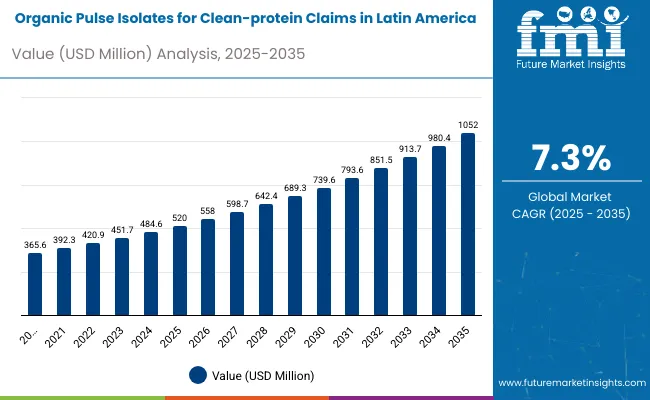
The rise in demand is linked to shifting protein preferences, growing clean-label requirements, and evolving fitness and health consciousness trends. By 2025, per capita consumption in leading Latin American countries such as Mexico, Brazil, and Argentina averages between 0.3 to 0.5 kilograms, with projections reaching 0.7 kilograms by 2035. São Paulo leads among metropolitan areas, expected to generate USD 38 million in organic pulse isolate sales by 2035, followed by Mexico City (USD 32 million), Buenos Aires (USD 18 million), Lima (USD 14 million), and Santiago (USD 11 million).
The largest contribution to demand continues to come from pea protein isolates, which are expected to account for 38% of total sales in 2025, owing to superior amino acid profiles, neutral taste characteristics, and growing import availability. By application segment, beverages represent the dominant usage category, responsible for 35% of all sales, while protein bars and supplements and plant-based dairy alternatives are expanding rapidly.
Consumer adoption is particularly concentrated among urban millennials and fitness enthusiasts, with income levels and urbanization emerging as significant drivers of demand. While price remains elevated compared to conventional protein sources, the average premium has stabilized at 23% over standard plant proteins in 2025. Continued improvements in regional supply chains and local processing initiatives are expected to accelerate affordability and access across middle-income wellness categories. Country disparities persist, but per capita demand in emerging wellness hubs is narrowing the gap with traditionally strong metropolitan centers.
The organic pulse isolates segment in Latin America is classified across several dimensions. By protein source, the key categories include pea protein isolates, lentil protein isolates, chickpea protein isolates, and black bean protein isolates. By application, the segment spans beverages, protein bars and supplements, plant-based dairy alternatives, sports nutrition products, and health-focused baked goods. By processing method, formulations include water extraction, enzymatic processing, alkaline extraction, and traditional fermentation techniques.
By consumer profile, the segment covers urban millennials, fitness enthusiasts, health-conscious professionals, young families, and individuals managing dietary restrictions. By country, regions such as Brazil, Mexico, Argentina, Colombia, and Chile are included, along with coverage across 18 Latin American countries. By city, key metro areas analyzed include São Paulo, Mexico City, Buenos Aires, Lima, and Santiago.
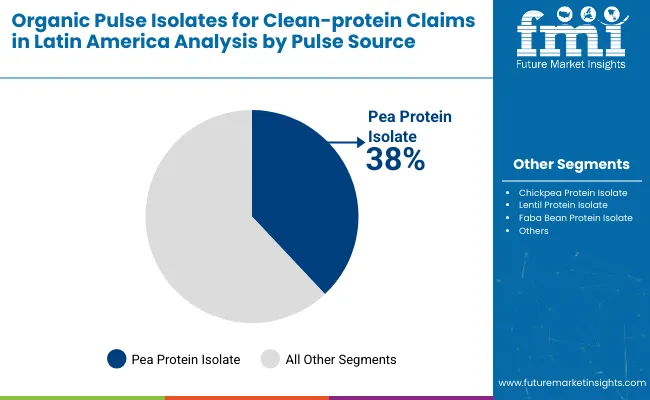
Pea protein isolates are projected to dominate sales in 2025, supported by established import channels, clean taste profile, and growing consumer awareness. Other pulse sources such as lentil, chickpea, and black bean are growing steadily, each serving distinct nutritional and cultural preferences.
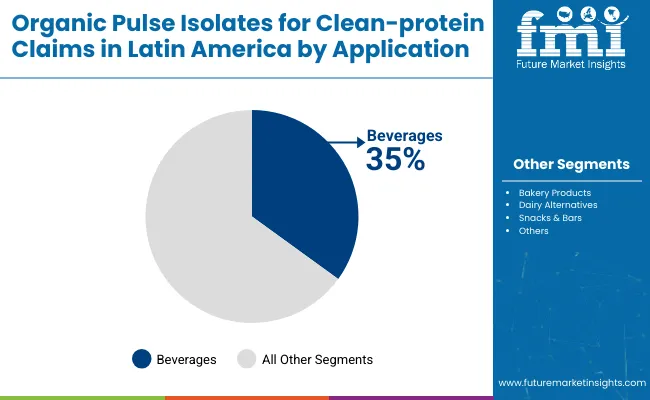
Organic pulse isolates in Latin America are utilized across diverse functional food and beverage applications. Beverages are expected to remain the primary usage category in 2025, followed by protein bars and supplements and plant-based dairy alternatives. Application strategies are evolving to match consumer wellness behaviors, with growth coming from both imported premium products and emerging local formulations.
Organic pulse isolates in Latin America utilize various extraction and processing methods, selected for protein yield, cost effectiveness, and clean-label compatibility. Water extraction remains the most widely used processing approach, though enzymatic processing and traditional methods are gaining momentum for specific regional applications.
The organic pulse isolates category appeals to a diverse consumer base across age groups, income levels, and wellness priorities. While motivations vary from performance enhancement to health consciousness to dietary restrictions, demand is concentrated among five key demographic clusters. Each group brings distinct purchase behaviors, price sensitivity, and product expectations.
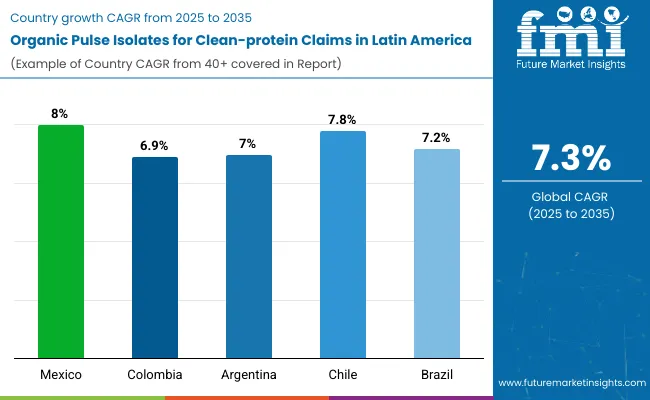
Organic pulse isolate sales will not grow uniformly across every country. Rising wellness culture adoption and faster per-capita spending in Mexico and Chile give these countries a measurable edge, while established wellness centers such as Brazil expand more steadily from a higher base. The table below shows the compound annual growth rate (CAGR) each of the five largest countries is expected to record between 2025 and 2035.
Between 2025 and 2035, demand for organic pulse isolates is projected to expand across all major Latin American countries, but the pace of growth will vary based on wellness culture penetration, import infrastructure, and baseline consumption levels. Among the top five countries analyzed, Mexico is expected to register the fastest compound annual growth rate (CAGR) of 8.0%, followed closely by Chile at 7.8%, outpacing more established wellness centers.
This acceleration is underpinned by a combination of factors: expanding middle class, growing fitness culture, and increasing availability of imported wellness products across premium retailers and specialty nutrition stores. In both countries, per capita consumption is projected to rise significantly, closing the gap with higher-consumption countries such as Brazil and Argentina. Retail assortment is also expanding faster in these regions, with new organic protein formats gaining traction in shopping malls and fitness-focused retail outlets.
Brazil and Argentina are forecast to grow at CAGRs of 7.2% and 7.0% respectively over the same period. Both countries already maintain established import ecosystems, with widespread access to organic pulse isolates in premium supermarkets, specialty nutrition stores, and international brand retailers. In Brazil, growth is supported by a strong health-conscious consumer base, established wellness culture, and increasing uptake of imported wellness products. Argentina reflects similar dynamics, particularly among professional classes and health-focused consumers seeking performance nutrition. In both countries, per capita consumption is projected to increase steadily, reflecting mainstreaming of imported plant protein options.
Colombia, while maintaining significant growth potential, is expected to grow at a CAGR of 6.9%, slightly below its regional counterparts. The country is developing its wellness retail infrastructure and import capabilities, with growth coming from urban center expansion and increasing health consciousness rather than established wellness culture.
Collectively, these five countries represent the core of wellness-driven demand for organic pulse isolates in Latin America, but their individual growth paths highlight the importance of regional tailoring in import strategies, pricing approaches, and retail channel development.
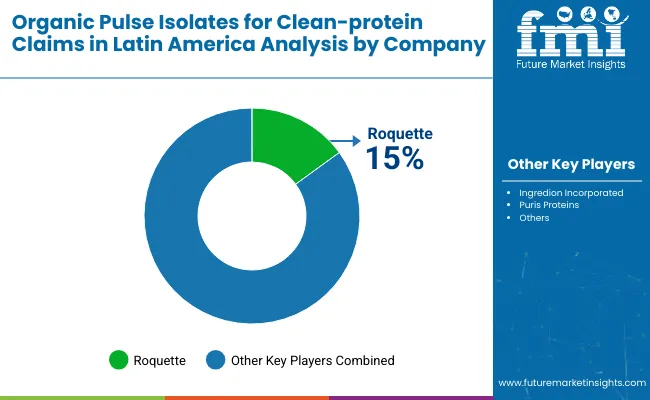
The competitive environment is characterized by a mix of international ingredient suppliers and emerging regional distributors. Import capacity and distribution network breadth rather than local processing capability remains the decisive success factor: the five largest suppliers collectively serve more than 400 food and beverage manufacturers across Latin America and account for a majority of organic pulse protein supply in the region.
Roquette is the most established participant in the Latin American organic pulse isolates space, holding a 15% share of the regional demand. The French-headquartered company operates distribution centers in Mexico and Brazil, offering USDA organic-certified pea protein isolates with consistent 80-85% protein content. Its core ingredient portfolio gives it deep penetration in sports nutrition and functional food categories while maintaining regional coverage through local distributors and co-packers.
Ingredion, through its nutrition division, leverages extensive Latin American distribution infrastructure to supply organic pulse isolates to major food manufacturers and private label brands. Strategic partnerships with regional importers and investments in cold-chain logistics have allowed Ingredion to introduce premium organic isolates with competitive pricing, reinforcing its role as a primary supplier for mainstream wellness brands.
ADM benefits from established international trade relationships and dedicated organic supply chains serving the Latin American wellness sector. Recent expansion of distribution partnerships in Colombia and Chile under international organic certification standards extends beyond commodity ingredients into branded organic protein powders targeting the premium urban segment.
The next tier comprises regional distributors and emerging local processors. BRF S.A. focuses on protein ingredient distribution and contract importing; recent quarterly reports showed growing wellness ingredient revenues of USD 8 million, signaling regional expansion. Grupo Bimbo, primarily known for baked goods, adds organic protein ingredients to its supply chain and benefits from extensive retail relationships across Mexico and Central America.
Private-label programmes at major retailers like Walmart Mexico, Carrefour Brasil, and Cencosud are expanding organic pulse isolate offerings at price points 15-20% below international branded equivalents, putting margin pressure on smaller importers while supporting category growth. Consolidation is therefore likely to continue as import licensing costs and distribution scale become critical for maintaining supply reliability and competitive pricing in this premium-focused category.
| Attribute | Details |
| Study Coverage | Latin America sales and consumption of organic pulse isolates for clean-protein claims from 2020 to 2035 |
| Base Year | 2025 |
| Historical Data | 2020 |
| Forecast Period | 2025-2035 |
| Units of Measurement | USD (sales), Metric Tonnes (volume), Kilograms per capita (consumption) |
| Geography Covered | 18 Latin American countries; country-level and city-level granularity |
| Top Countries Analyzed | Brazil, Mexico, Argentina, Colombia, Chile, 18+ |
| Top Cities Analyzed | São Paulo, Mexico City, Buenos Aires, Lima, Santiago and 25+ |
| By Source | Pea protein isolates, Lentil protein isolates, Chickpea protein isolates, Black bean protein isolates |
| By Application | Beverages, Protein bars/supplements, Plant-based dairy, Sports nutrition, Health-focused baked goods |
| By Processing Method | Water extraction, Enzymatic processing, Alkaline extraction, Traditional fermentation |
| By Consumer Profile | Urban millennials, Fitness enthusiasts, Health-conscious professionals, Young families, Dietary-restricted consumers |
| Metrics Provided | Sales (USD), Volume (MT), Per capita consumption (kg), CAGR (2025-2035), Share by segment |
| Price Analysis | Average unit prices by protein source and import origin |
| Competitive Landscape | Company profiles, distribution strategies, import capacity, international vs. regional |
| Forecast Drivers | Per capita wellness spending, urbanization trends, import infrastructure development, health consciousness growth |
By 2035, total Latin America sales of organic pulse isolates for clean-protein claims are projected to reach USD 1.05 billion, up from USD 0.52 billion in 2025, reflecting a CAGR of approximately 7.3%.
Pea protein isolates hold the leading share, accounting for approximately 38% of total sales in 2025, followed by lentil protein isolates and chickpea protein isolates.
Mexico leads in projected growth, registering a CAGR of 8.0% between 2025 and 2035, followed by Chile at 7.8%, due to expanding middle class and increasing wellness culture adoption.
Beverages are the dominant application category (35% share in 2025), followed by protein bars and supplements, with plant-based dairy alternatives growing at double-digit CAGR, especially in urban metropolitan areas.
Major players include Roquette (15% share), Ingredion, ADM, BRF S.A., and Grupo Bimbo, with growing competition from private label brands like Walmart Mexico and Carrefour Brasil organic protein offerings.






Our Research Products

The "Full Research Suite" delivers actionable market intel, deep dives on markets or technologies, so clients act faster, cut risk, and unlock growth.

The Leaderboard benchmarks and ranks top vendors, classifying them as Established Leaders, Leading Challengers, or Disruptors & Challengers.

Locates where complements amplify value and substitutes erode it, forecasting net impact by horizon

We deliver granular, decision-grade intel: market sizing, 5-year forecasts, pricing, adoption, usage, revenue, and operational KPIs—plus competitor tracking, regulation, and value chains—across 60 countries broadly.

Spot the shifts before they hit your P&L. We track inflection points, adoption curves, pricing moves, and ecosystem plays to show where demand is heading, why it is changing, and what to do next across high-growth markets and disruptive tech

Real-time reads of user behavior. We track shifting priorities, perceptions of today’s and next-gen services, and provider experience, then pace how fast tech moves from trial to adoption, blending buyer, consumer, and channel inputs with social signals (#WhySwitch, #UX).

Partner with our analyst team to build a custom report designed around your business priorities. From analysing market trends to assessing competitors or crafting bespoke datasets, we tailor insights to your needs.
Supplier Intelligence
Discovery & Profiling
Capacity & Footprint
Performance & Risk
Compliance & Governance
Commercial Readiness
Who Supplies Whom
Scorecards & Shortlists
Playbooks & Docs
Category Intelligence
Definition & Scope
Demand & Use Cases
Cost Drivers
Market Structure
Supply Chain Map
Trade & Policy
Operating Norms
Deliverables
Buyer Intelligence
Account Basics
Spend & Scope
Procurement Model
Vendor Requirements
Terms & Policies
Entry Strategy
Pain Points & Triggers
Outputs
Pricing Analysis
Benchmarks
Trends
Should-Cost
Indexation
Landed Cost
Commercial Terms
Deliverables
Brand Analysis
Positioning & Value Prop
Share & Presence
Customer Evidence
Go-to-Market
Digital & Reputation
Compliance & Trust
KPIs & Gaps
Outputs
Full Research Suite comprises of:
Market outlook & trends analysis
Interviews & case studies
Strategic recommendations
Vendor profiles & capabilities analysis
5-year forecasts
8 regions and 60+ country-level data splits
Market segment data splits
12 months of continuous data updates
DELIVERED AS:
PDF EXCEL ONLINE
Organic Cosmetics Market Size and Share Forecast Outlook 2025 to 2035
Organic Salad Dressing Market Forecast and Outlook 2025 to 2035
Organic Fertilizer Market Size and Share Forecast Outlook 2025 to 2035
Organic Acai Juice Market Size and Share Forecast Outlook 2025 to 2035
Pulse Ingredient Industry Analysis in Japan Size and Share Forecast Outlook 2025 to 2035
Pulse Ingredient Industry Analysis in Western Europe Size and Share Forecast Outlook 2025 to 2035
Pulse Ingredient Industry Analysis in Korea Size and Share Forecast Outlook 2025 to 2035
Organic Beverages Market Size and Share Forecast Outlook 2025 to 2035
Pulse Safety Resistor Market Size and Share Forecast Outlook 2025 to 2035
Organic Drinks Market Size and Share Forecast Outlook 2025 to 2035
Organic Oats Market Size and Share Forecast Outlook 2025 to 2035
Organic Dried Distillers Grain Feed Market Size and Share Forecast Outlook 2025 to 2035
Organic Hemp Market Size and Share Forecast Outlook 2025 to 2035
Organic Electronics Market Size and Share Forecast Outlook 2025 to 2035
Organic Dyes Market Size and Share Forecast Outlook 2025 to 2035
Pulses Market Analysis - Size, Share, & Forecast Outlook 2025 to 2035
Organic Rankine Cycle Market Size and Share Forecast Outlook 2025 to 2035
Pulse Flours Market Size and Share Forecast Outlook 2025 to 2035
Pulse Lavage Market Size and Share Forecast Outlook 2025 to 2035
Organic Seed Varieties Market Size and Share Forecast Outlook 2025 to 2035

Thank you!
You will receive an email from our Business Development Manager. Please be sure to check your SPAM/JUNK folder too.
Chat With
MaRIA